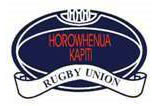
This small region centred on Levin has produced a number of players of outstanding talent. The Horowhenua Rugby Football Union was formed in 1893 and changed its name to Horowhenua Kapiti in 1997. The district had a brief taste of Ranfurly Shield glory in 1927 when a combined Manawatu-Horowhenua union (Manawhenua) defeated holders Wairarapa 18–16 and saw off two challengers. Trophies have been few and far between, with the union’s greatest individual achievement coming in 1993, when it won the NPC’s third division and gained promotion to the second division.
Horowhenua Kapiti plays in the semi-professional Heartland Championship. Along with East Coast, Poverty Bay, Hawke’s Bay, Wanganui, Manawatu, Wairarapa Bush and Wellington, it is part of the Hurricanes Super Rugby franchise.
The relationship with neighbours Manawatu has been important in the history of rugby in this area. The union’s first first-class match was an 8–3 defeat by Manawatu in 1899. As well as the official merger between 1925 and 1932, the two have combined on a number of occasions to play touring international teams. A number of talented players from Horowhenua-Kapiti have gone on to bigger and better things north of the Manawatu River.
The ones that got away
The histories of many of New Zealand’s smaller unions are littered with the names of players who were effectively forced to move to bigger unions to further their careers. Horowhenua Kapiti is no exception. A number of prominent All Blacks played their early first-class rugby in the red, white and blue of the ‘Nua’.
Forwards Gary Knight and ‘Cowboy’ Mark Shaw both moved from Horowhenua Kapiti to Manawatu in the 1970s and later became All Blacks. First-five-eighth Carlos Spencer was the star of the side that won the NPC third division title in 1993. This prodigious talent debuted for the union in 1992 as a 16 year old still playing for Waiopehu College. In 1993 he set a Horowhenua record for the most points in a season with 136. A small union had no chance of holding on to such a player, and in 1994 Spencer moved to Auckland. He had come to the attention of coach Graham Henry by scoring a spectacular solo try in an 80–17 Ranfurly Shield defeat. Spencer established himself as Grant Fox’s successor in the Auckland team, for which he scored more than 500 points. He also scored more than 600 points for the Blues Super rugby franchise between 1996 and 2003. His 291 test points for the All Blacks ranks him fourth on the all-time list.
Not far behind Spencer on that All Black points-scoring list is try-scoring sensation Christian Cullen. The ‘Paekakariki Express’ debuted for Horowhenua Kapiti in 1994 before rising to prominence with the New Zealand Sevens side and Manawatu in 1995. He made his All Black debut the following year at the age of 20 and in 58 tests scored a then-record 46 tries. With 236 points he is seventh on the All Blacks all-time points-scoring list.
Local heroes
Two players have been selected for the All Blacks while playing club rugby in Horowhenua Kapiti. Hohepa (Harry) Jacob from the Wanderers club played for New Zealand Maori and was selected for the All Blacks in 1920. Joe Karam played the last of his 10 tests in 1975 while based in Paraparaumu.
Like Carlos Spencer nearly 80 years later, Harry Jacob debuted for Horowhenua as a 16-year-old, in 1911. First selected for New Zealand Maori in 1913, he captained the 1922 side which toured Australia and New Zealand. His leadership qualities were in evidence during the First World War, in which he served as a lieutenant in the Pioneer Battalion. He toured New Zealand in 1919 with the Maori (Pioneer) Battalion side, playing in all nine games. He played more than 100 first-class games in total, a remarkable feat given the disruption of the war.
When peacetime rugby resumed Jacob became captain of Horowhenua, and from 1925 Manawhenua. After leading Manawhenua to Ranfurly Shield victory in 1927 he named his newborn son Ran Furly. The lad duly went on to play for Wellington and New Zealand Maori in the late 1940s.
Joe Karam is now better known to many New Zealanders for his vocal support for the convicted murderer David Bain. Karam funded much of the campaign which led to a 2009 retrial for Bain, who had been found guilty in 1995 of the murders of his parents and three siblings. Bain’s acquittal after the second trial has done little to lessen the controversy around the case. Others remember Karam as a fullback for Horowhenua, Wellington and the All Blacks. In his 42 games for New Zealand Karam scored 345 points. In 1976 he switched to rugby league, playing for Auckland club side Glenora and representing Auckland and North Island.
Paul Hirini made a record 153 appearances for the union between 1986 and 2000. Craig Laursen scored a record 440 points in just six seasons, 1984 to 1989.
Tell us your Horowhenua Kapiti rugby stories
Add your story to the Community contributions section below. We're also keen to get more regional rugby images - please email us at [email protected] if you can help.

Community contributions